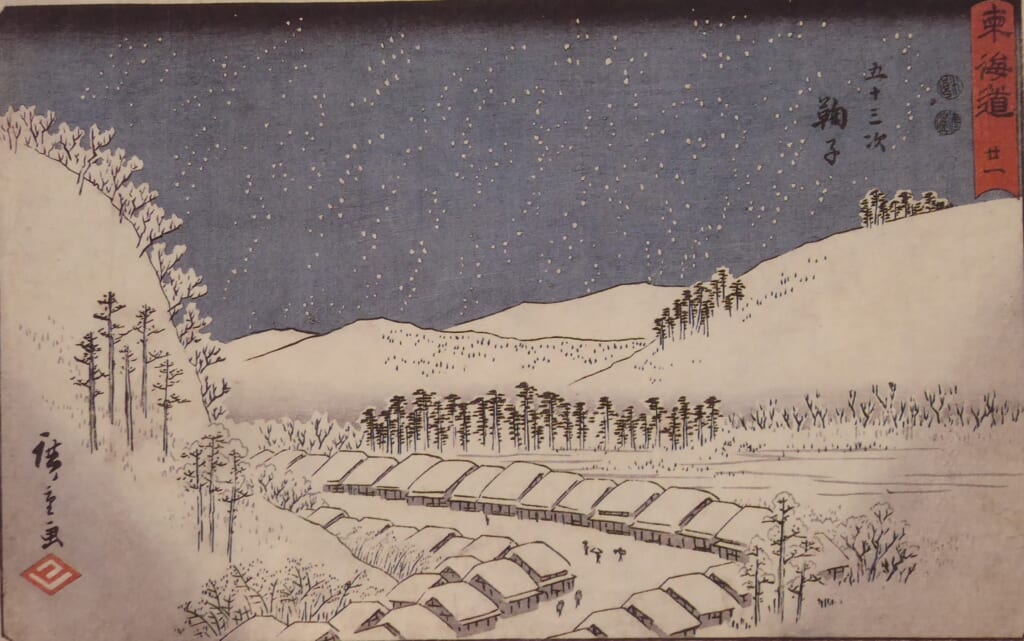Explanation of the Fifty-three Stations of the Tokaido 21 Mariko
7.9km from Okabe to Maruko, 34°56′57.0″N 138°20′34.0″E
Mariko is the 20th post town on the Fifty-three Stations of the Tokaido.
It is also written as Maruko.
In the later writing, “Maruko” has been changed to “Mariko”.
It is currently Maruko, Suruga Ward, Shizuoka City, Shizuoka Prefecture.
There is one main inn, two side inns, 24 lodgings, a population of 795, 211 houses, and the length of the inn is about 800m.
It is the smallest post town on the Tokaido.
There is a ruin of a notice board near Maruko Bridge on the Abe River, and a replica of the notice board that still exists in the post town stands.
Jippensha Ikku used tororo soup in the Maruko scene of “Tokaidochu Hizakurige”.
Chojiya is one of the restaurants that serves the specialty tororo soup of Mariko-juku.
Its address is 10-10 Maruko 7-chome, Suruga-ku, Shizuoka City.
It was founded in 1596 at the end of the Sengoku period, and has been in business at the same location ever since.
It currently serves only food and drink, but originally it was a teahouse that also operated as a lodging facility.
Choji refers to the spice chokou, which was a valuable commodity at the time.
It is located about a 3-minute walk west of the main camp site, and serves the specialty tororo soup as well as a set menu.
The famous teahouse depicted by Utagawa Hiroshige is introduced as Chojiya.
At the time, there were multiple teahouses that served tororo soup.
There is no clear evidence that the building depicted by Hiroshige is Chojiya.
The commentary on the ukiyo-e prints simply describes it as a “famous teahouse.”
In 1970, when the 12th head of the family, Shibayama Nobuo, incorporated the business, he moved the old house to resemble the 53 Stations.
At the time, the area around Maruko was a typical rural area.
Shibayama learned that Chojiya had once been visited by Matsuo Basho and Utagawa Hiroshige.
Wanting to evoke this tradition, he came up with the idea of making the Chojiya building look like the thatched buildings depicted in the 53 Stations.
Shibayama spent a total of 40 million yen over 20 years to collect all of the prints from “The 53 Stations of the Tokaido.”
The prints of “The 53 Stations of the Tokaido” that Shibayama collected are in Chojiya’s collection.
The ceramic ukiyo-e prints that were on display in the store were taken off display due to the earthquake.
① “Hoeido version”
The road leaves the coast and heads up the mountain.
This is the scene of Mariko-juku, described in Matsuo Basho’s haiku “Plums, young leaves, Mariko-juku’s tororo soup.”
A sign reading “Famous grated yam soup” is propped up at the tea shop.
A traveler sits on a floor cushion and eats the famous tororo soup with a big mouthful, looking pleased.
A woman carrying a baby on her back brings more soup.
There are also signs reading “Ochazuke” and “Sake Sakana.”
Inside the shop, you can see fish skewered on straw mats and dried persimmons.
You can see Mount Yokota behind the tea shop.
② “Gyosho version”
This depicts the famous tororo soup.
This is a spring scene with red and white plum blossoms in bloom and birds chirping.
The depiction of the people inside the tea shop is wonderful.
③ “Reisho version”
It depicts a post town with snow falling steadily.
You can get a good idea of what the post town looks like as a whole.
④ “Hokusai version”
It shows people grating yam to make tororo soup at an inn.
A horse trader is unloading luggage from a horse.
⑤ “Travel image”
This is the current Chojiya.
⑥ “Stamp image”
This is a stamp from Mariko post town.
Hoeido version

Gyousyo version

Reisho version

Hokusai version

Travel image

Stamp image



